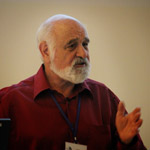Interview with Michael Arbib

This post-lecture interview was conducted during the BCBT Summerschool held at the Universitat Pompeu Fabra, Barcelona, september 2010.
During his long and distinguished career, Michael Arbib (University of Southern California, USA) studied a wide variety of aspects that have to do with the relation between vision, and action. One aspect of his work focuses on the theory of perceptual schemas, a theoretical model to address what goes in between the psychological level of action and behavior in a world, and the lower levels of neural processing. With Tony Prescott and Paul Veschure he discusses the important limitations computational modeling has with respect to how behavior is effectively implemented in neuronal structures. Another key turn in his research came with the discovery of mirror neurons, which are neurons that fire not only in relation to action of the animal itself, but also to the perception of the performance of that action by other animals. From research on the localization of mirror neuron systems in human brains Arbib c.s. found, that our current language system has probably evolved from brain areas that generated and controlled gestures. This calls to view what we now call human language from a much larger perspective than one of speech or writing alone. In the view of Arbib it also calls to apply a framework of study that focuses not only on the processing of neurons in an isolated individual, but also to the embedding of it in social and cultural structures of the present, and the past of evolution.
About the lecturerMichael Arbib is Professor in Computer Science, Neurobiology, Physiology, Biomedical Engineering, Electrical Engineering, and Psychology at the University of Southern California, Fletcher Jones Professor of Computer Science, and director of the USC Brain Project. The core of Michael Arbib's work is expressed in the title of his first book, Brains, Machines and Mathematics (McGraw-Hill, 1964). He has written or edited more than 40 books on these topics since. His career is based on the argument that we can learn much about machines from studying brains, and much about brains from studying machines. He has thus always worked for an interdisciplinary environment in which computer scientists and engineers can talk to neuroscientists and cognitive scientists.